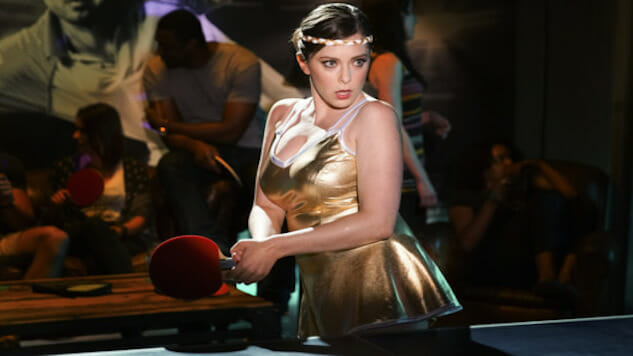Paula Proctor is the Disney princess we need right now. In “Maybe This Dream,” her first big number of Crazy Ex-Girlfriend’s second season, Donna Lynne Champlin channels Snow White—if Snow White had some sense in her head and a lifetime of self-esteem issues to face. Twirling through the forest-fied Whitefeather & Associates office, replete with moss-covered cubicles, Paula becomes the heroine of a story that seems freshly feminist compared to her aria’s genre.
Broadway veteran Champlin has the high, lilting soprano that floats from both Snow White and Sleeping Beauty, but she shines in transition from this more traditional, “legit” style—classically influenced musical theatre—to the sing-speech of Ariel from The Little Mermaid. She has tremendous vibrato, operatic pronunciation and the kind of bird-like vocalizing fairy tale knock-offs love to parody. Her vowels are large and her words are round and elegant, even when referring to a crapping seagull or period cramps. When she shifts to delivering clever asides, melding the choreography for scattering birdseed with a jack-off motion, it’s clear this princess isn’t one of Disney’s beloved ingénues.
From her flowing, bodice-covered dress and her plain beige headband to her wicker basket and the sepia lighting, Paula’s song is an ode to disappointment and broken promises. She’s the pre-transformation princess. The glamour-less princess. Where are the solutions these stories fed to young girls? Paula’s no longer looking—she’s taking things into her own hands.
Prince Charming didn’t solve her problems. If anything, he knocked her up (twice) and sideswiped her ambition with responsibilities. Since then, her life hasn’t been her own. With two kids, dreaming hasn’t been a luxury Paula could afford.
Now, as Paula continues to move forward from the obsessive rut that’s formed the foundation of her and Rebecca’s friendship, she’s going back to school to become an attorney. Her dreams are relentlessly careerist, though the song mostly alludes to uncertain love (fleeing her wedding, an unreliable vibrator) and personal embarrassment (her pride is compared to the rotting corpse of Bambi—well, a deer, anyways). Paula has tried and been burned before, which the number hilariously juxtaposes with the feel-good melody of Disney’s young royalty.
Without hearing the classic orchestration, the scene is immediately recognizable. The camerawork and set design help establish the Disney aesthetic even to the deaf. As Paula twirls, so does the camera, and as she tiptoes through the greenery, it tracks alongside her. The layers of foliage (all seemingly real) and the misty floor help generate a lot of depth as the choreography takes Paula back and forth. This depth is standard in Disney animations. Think about how often the “camera” zooms past flora in the foreground to find its subject in those golden age films.
Thematically, though, the song rejects its closest influences. Snow White, allegedly fourteen (yikes), exists in a plot that revolves around her looks. Paula exists in a world where she, as a middle-aged woman, has to actively try to spice up her marriage’s romance or else be forgotten. Her brief fling with Calvin Young (Cedric Yarbrough) was unfulfilling and eye-opening. Her romantic problems have been maturely addressed and she must move on to another route to happiness, something most women her age have attained: professional success.
You can’t look up to a princess when you’ve got kids their age. You have to be your own princess. The supporting birds (Michael McMillian and Burl Moseley, in hilariously flamboyant headdresses and wings) tweedle-dee with the best of them, but they’re not helpful woodland creatures. She’s her own hero and doesn’t need any help, especially from smarmy male colleagues. They’re just part of the scenery, fleeing when Paula picks up the tempo and addresses her more personal problems.
The worse her body acts, the more it betrays her with age and experience, the closer the analogy to her dreams. Hope is a dangerous thing for someone as jaded as Paula, but it’s the difference between her progress and Rebecca’s stagnation. The song ends classically, though with a much more scatalogically disgusting climax than anything in Cinderella, and is followed by silence. Picking back up, the final choral diminuendo and wistful sigh from Paula cross-fades with office sounds, a ringing telephone coming in as the most prominent messenger of both the constant demands on Paula’s time and the realities of her job. Dreaming reasonable dreams (for yourself) within reality isn’t just the message of the song, it’s a grounding principle for Paula’s growth—not to mention a much healthier moral for a Disney princess to pass on.
Jacob Oller is a writer and film critic whose writing has appeared in The Guardian, Playboy, Roger Ebert, Film School Rejects, Chicagoist, Vague Visages, and other publications. He lives in Chicago, plays Dungeons and Dragons, and struggles not to kill his two cats daily. You can follow him on Twitter here: @jacoboller.
